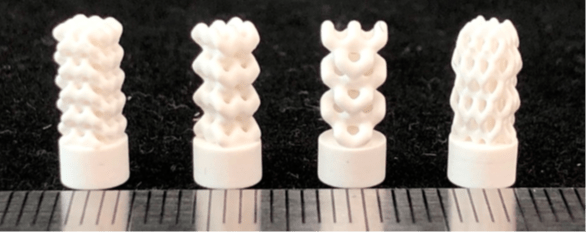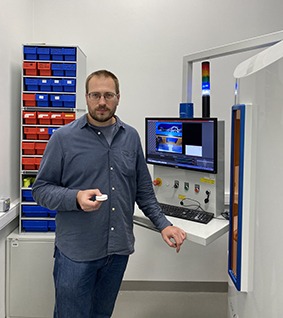This study demonstrates the wide range of printing possibilities of our technology particularly in the biomedical field, thank's to the accuracy, the printing speed of our printers and our slurry !

Skoltech Center for Design, Manufacturing, and Materials (CDMM) have developed a method for designing and manufacturing of complex shaped ceramic bone implants with a controllable pre-engineered porous structure. These implants largely enhance tissue fusion efficiency. This study has been conducted by Sviatoslav Chugunov, Senior Research Scientist at Skoltech Center for Design, Manufacturing and Materials. Mr Sviatoslav Chugunov has answered our questions :

Q : What are the advantages of these new implants?
Sviatoslav Chugunov : The implants have various porous structures, which are used to ensure effective cell growth around the implant. For tissue fusion to be more efficient, the pores should have a size of several hundred microns, while the implants could be bigger than the pores by several orders of magnitude. Our study demonstrated not only the possibility of producing pores of different sizes, but also of 3D printing implants with broad strength characteristics, making the choice of the right structure for each patient much easier.
Q. And why 3D printing method to produce them?
SC : There are several methods of producing highly porous ceramic materials, allowing a trade-off between ceramics porosity and the strength of implants. These are, in particular, the use of foaming and burnt-out additives, and the method of replicas. However, these methods are difficult to control. Besides the porous structure, the items have to be complexly shaped. The 3D printing allows the fabrication of parts of any shape, implementing a personalized approach to patients’ treatment that involves the use of computerized tomography, while controlling porosity, interconnectivity, and the size of pores, necessary for better implant acceptance within the damaged area. Modern implants feature such complex shaped that the regular CAD approaches hardly work for parametrized implant geometry. So, the use of FRep method for modeling and ceramic 3D printing for manufacturing of implants is the only way to efficiently produce such complex parts.

Q. Why ceramics are used for these implants? It is not the easiest material to work with?
SC : Ceramic materials, such as 3DCeram’s commercial alumina mix used in this research, have great dimensional stability, are biologically inert, resistant to wear and chemicals, and mechanically sound, which makes them a perfect fit for bone implants that can be custom-made thanks to advanced 3D printing technology, unmissable here to obtain the structure we want to obtain.
Q. What are the challenges you had to rise by modelling these ceramic bone implants and why did you develop this “Functional Representation method”?
SC : Conventional geometric modeling with the part representation limited to its surface does not work here due to the too complex internal structure of the implant and the necessity of introducing a parametrized approach. The FRep-based modeling leads to the well-defined simple and easily adjustable resulting model. It ensures complete parametrization of the resulting microstructures and offers high flexibility in the fast generation of variable 3D models. Finally, it offers a diversity of tools for modeling various mesh structures that traditional CAD cannot insure.
Q. In how much time could you get first positive results of the manufacturing?
SC : The development of the computer model of the implants takes not more than 1 day. It includes the building of the base parametrized model and generating a variety of child models, where geometry is altered with the help of parameters. Each additional model can be done within seconds. The manufacturing of implants is done with a standard SLA-based 3D-printing procedure, including subsequent thermal processing, The entire process takes on average 7-10 days. While the 3D-printing operations are very fast, the thermal treatment of the ready green parts might take a few days.
Q. What are the difficulties did you encounter during the development of manufacturing process?
SC : . The only difficulties we had were related to the building of the computer models of the implnats, when we originally used CAD software. After realizing the drawbacks of the standard approach, we switched to FRep-based design and finished the process in one day. The 3D-printing process posed no difficulties, since the technology is mature enough to efficiently handle complex geometries.
Q. Skoltech Center for Design owns SLA ceramic 3D printer by 3DCeram Sinto. Why SLA technology has been used for this innovative research?

SC :. High resolution of polymerization, high accuracy and homogeneity of the part thanks to the use of precise laser-based UV light source, open system parameters, which allowed us to “play” with different features, absence of physical supports when printing, which allows to avoid any mechanical machining of parts.
Q. What advise should you give to those who start looking at Additive manufacturing?
SC :. I would give 2 main advises to new entrants i) Right determination of needs and targets, which will define the right tool to choose; ii) possibility to scale up the results of research works to industry, i.e. availability of real industrial AM tools.